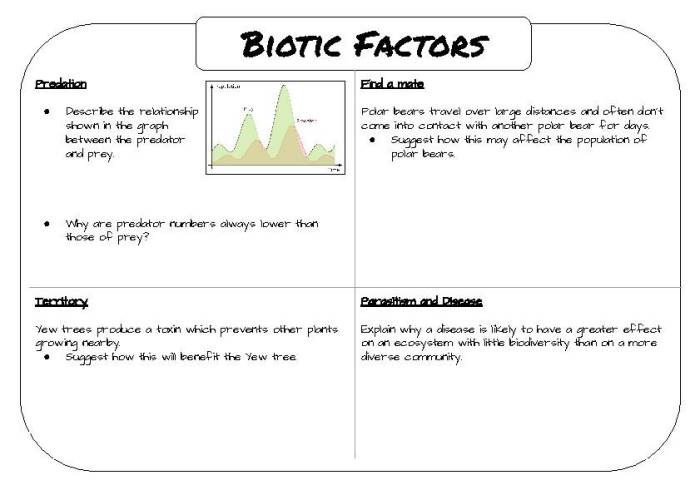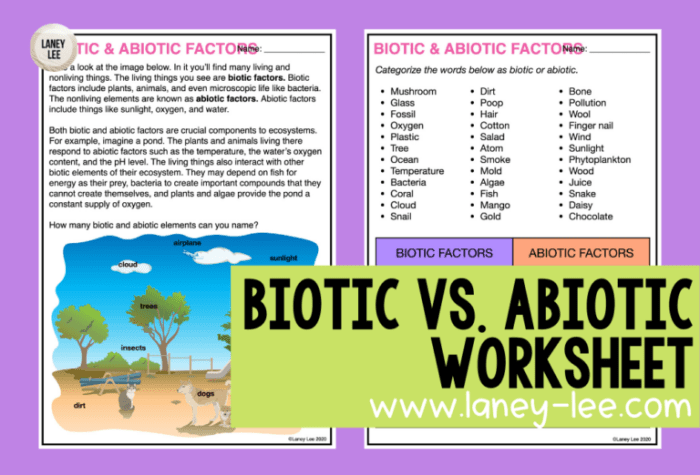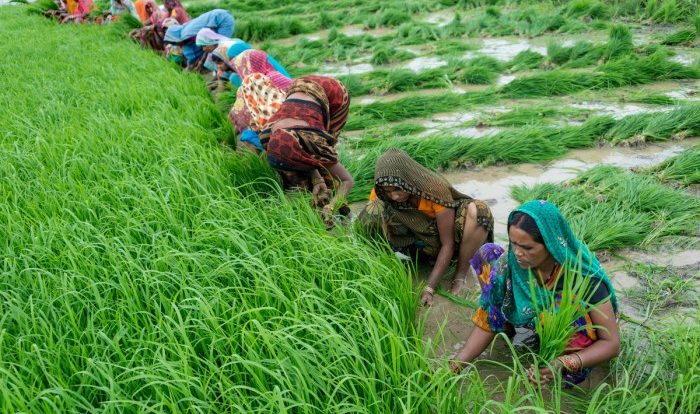Abiotic vs biotic factors worksheet answer key – Delving into the captivating realm of ecology, we present the Abiotic vs. Biotic Factors Worksheet Answer Key, an invaluable resource for comprehending the intricate interplay between living organisms and their surroundings. This guide unveils the fundamental concepts, examples, and significance of these factors, empowering you to unravel the complexities of ecosystems.
Within this comprehensive answer key, you’ll discover precise definitions of abiotic and biotic factors, unravel their interconnectedness, and gain insights into the methods used to identify them. Moreover, an interactive activity awaits, providing an engaging and immersive experience that solidifies your understanding.
Abiotic and Biotic Factors

Abiotic factors are non-living components of an ecosystem that influence the survival and distribution of living organisms. These include physical and chemical elements such as temperature, water, sunlight, soil, and nutrients.
Biotic factors are living organisms that interact with each other and their environment. These include plants, animals, bacteria, and fungi.
Abiotic and biotic factors are closely intertwined and influence each other. For example, temperature affects the distribution of plants and animals, while plants and animals provide food and shelter for each other.
Worksheet Answer Key: Abiotic Vs Biotic Factors Worksheet Answer Key

1. Abiotic Factors
- Temperature
- Water
- Sunlight
- Soil
- Nutrients
2. Biotic Factors
- Plants
- Animals
- Bacteria
- Fungi
3. Relationship between Abiotic and Biotic Factors
- Abiotic factors influence the survival and distribution of biotic factors.
- Biotic factors interact with each other and their environment.
- Abiotic and biotic factors are closely intertwined and influence each other.
Examples of Abiotic and Biotic Factors

| Ecosystem | Abiotic Factors | Biotic Factors |
|---|---|---|
| Forest | Temperature, water, sunlight, soil, nutrients | Trees, shrubs, animals, insects, fungi |
| Grassland | Temperature, water, sunlight, soil, nutrients | Grasses, animals, insects, birds |
| Desert | Temperature, water, sunlight, soil, nutrients | Cacti, animals, reptiles, insects |
| Ocean | Temperature, water, sunlight, salinity, nutrients | Fish, plants, animals, microorganisms |
Methods for Identifying Abiotic and Biotic Factors
*
-*Observation
Observe the physical and chemical characteristics of the environment and the organisms present.
-
-*Measurement
Measure environmental variables such as temperature, water, and soil pH.
-*Sampling
Collect samples of organisms and analyze their characteristics.
-*Experimentation
Conduct experiments to determine the effects of abiotic factors on biotic factors.
It is important to use multiple methods to accurately identify abiotic and biotic factors.
Importance of Abiotic and Biotic Factors

* Abiotic and biotic factors are essential for the functioning of ecosystems.
- They interact to maintain ecological balance.
- Changes in abiotic or biotic factors can impact an ecosystem.
For example, a decrease in temperature can lead to a decrease in plant growth, which can in turn lead to a decrease in animal populations.
Key Questions Answered
What is the difference between abiotic and biotic factors?
Abiotic factors are non-living components of an ecosystem, such as sunlight, water, temperature, and soil, while biotic factors are living organisms, including plants, animals, and microorganisms.
How are abiotic and biotic factors interrelated?
Abiotic factors provide the essential resources and conditions that support the survival and growth of biotic factors, while biotic factors influence the abiotic environment through their activities, such as nutrient cycling and oxygen production.
What are some examples of abiotic and biotic factors in a forest ecosystem?
Abiotic factors: sunlight, temperature, humidity, soil pH. Biotic factors: trees, shrubs, animals, fungi, bacteria.
